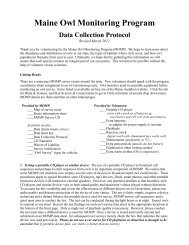Focus Species Forestry - Maine Audubon
Focus Species Forestry - Maine Audubon
Focus Species Forestry - Maine Audubon
You also want an ePaper? Increase the reach of your titles
YUMPU automatically turns print PDFs into web optimized ePapers that Google loves.
Chestnut-sided Warbler<br />
Distribution: Alberta to New Brunswick, south along the Appalachians<br />
to Georgia<br />
<strong>Maine</strong> <strong>Focus</strong> Region: Statewide.<br />
Territory: 1-3 acres<br />
Food: Insectivorous; prefers caterpillars and fly larvae<br />
Special Habitat Needs: Dense early successional hardwoods up to 10<br />
ft. tall with less than 35% overstory canopy closure. Prefers forest<br />
patches in excess of 250 acres.<br />
Management:<br />
Use group selection to create patches averaging 1 acre in size, or<br />
shelterwood or clearcut harvests, to create nesting habitat for<br />
chestnut-sided warblers.<br />
Balance early successional habitat with requirements of matureforest<br />
species at the property or landscape level. See landscape<br />
management guidelines (Section 8).<br />
Comments: Males defend their territory by singing from tall saplings and residual overstory trees while the female<br />
incubates 4-5 eggs in the brush below. John James <strong>Audubon</strong> considered this one of the rarest birds in the east<br />
during the early 1800s, but timber harvesting and regrowth of farmland have made it a relatively common species.<br />
Management for the chestnut-sided warbler will benefit other species that use early successional hardwoods, such<br />
as moose, woodcock, white-tailed deer, nighthawk, willow flycatcher, eastern bluebird, Tennessee warbler, and<br />
mourning warbler. The chestnut-sided warbler’s loud “pleased pleased pleased to meet-ya” may be confused with<br />
the magnolia warbler during the spring and early summer breeding season when the two species may be found<br />
together in mixed hardwood-conifer stands.<br />
Habitat Use:<br />
Aspen-Birch<br />
Forest Ecosystems<br />
Northern<br />
Hardwoods Oak-Pine Hemlock Spruce-Fir<br />
N. White<br />
Cedar<br />
R S I M R S I M L R S I M L I M L R S I M L I M L<br />
Special-value<br />
Habitats<br />
Riparian/<br />
Wetland Vernal<br />
Forest Pool<br />
R Regeneration and seedlings Mx Mixed conifer-deciduous <strong>Focus</strong> habitat<br />
S Saplings and small poles U Understory present Other habitat<br />
I Intermediate-aged forest C Cavity tree or snag Little/no use<br />
M Mature forest<br />
L Late-successional forest<br />
References: Boone and Krohn 1998, DeGraaf and Yamasaki 2001, Hagan et al. 1997, King 2003, Sauer et al.<br />
2003, Sibley 2000, Terres 1991<br />
48<br />
<strong>Focus</strong> <strong>Species</strong> <strong>Forestry</strong>



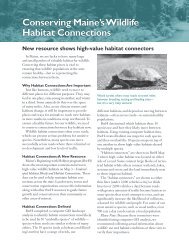
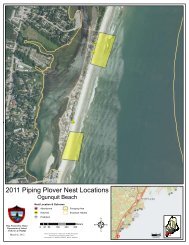
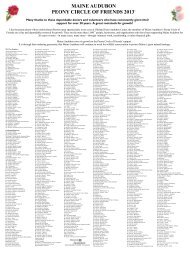
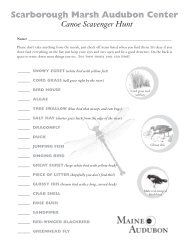


![2012 Loon Count Results [pdf] - Maine Audubon](https://img.yumpu.com/26228732/1/190x245/2012-loon-count-results-pdf-maine-audubon.jpg?quality=85)
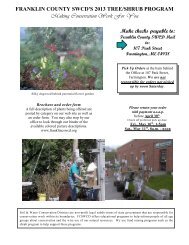
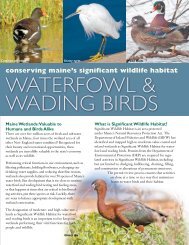
![Lake Fish of Maine (DIFW list) [pdf] - Maine Audubon](https://img.yumpu.com/23282964/1/190x245/lake-fish-of-maine-difw-list-pdf-maine-audubon.jpg?quality=85)
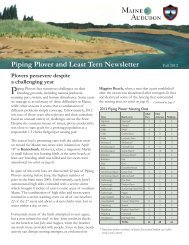

![The Maine Audubon Peony Circle of Friends 2012 [pdf]](https://img.yumpu.com/22707677/1/190x253/the-maine-audubon-peony-circle-of-friends-2012-pdf.jpg?quality=85)
